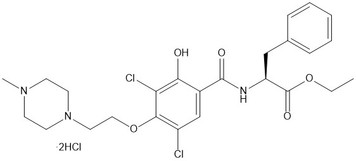JTE-607 | mRNA processing inhibitor
NMR (Conforms)

Available Options
| Size: | Price | Quantity | |
|---|---|---|---|
| 5 mg | $60.00 | ||
| 25 mg | $225.00 |
JTE-607 (188791-09-5) inhibits inflammatory cytokine production in human peripheral blood mononuclear cells (PBMC’s) without causing immunosuppression: IC50’s = 11 nM (TNF-α), 5.9 nM (IL-1β), 8.8 nM (IL-6), 7.3 nM (IL-8), and 9.1 nM (IL-10).1 It displayed efficacy in a mouse model of septic shock.2 JTE-607 also showed inhibitory activity against acute myelogenous leukemia cell lines.3,4 Recently, the mechanism of action of JTE-607 (a pro-drug, with the active species being the free acid) has been found to be inhibition of pre-messenger RNA endonuclease Cleavage and Polyadenylation Specificity Factor 3 (CPSF3).5,6 This prevents release of newly synthesized mRNA’s resulting in read-through transcription and the formation of DNA-RNA hybrid R-loop structures. Transcripts down-regulated by JTE-607 were related to DNA damage-based phenotype.
References/Citations
1) Kakutani et al. (1999), JTE-607, a novel inflammatory cytokine synthesis inhibitor without immunosuppression, protects from endotoxin shock in mice; Inflamm. Res., 48 461
2) Iwamura et al. (2004), Comparative study of glucocorticoids, cyclosporine A, and JTE-607 [(-)-Ethyl-N{3,5-dichloro-2-hydroxy-4-[2-(4-methylpiperazin-1-yl)ethoxy]benzoyl]-L-phenylalaninate dihydrochloride] in a mouse septic shock model; J. Pharmacol. Exp. Ther., 311 1256
3) Uesato et al. (2006), JTE-607, a multiple cytokine production inhibitor, ameliorates disease in a SCID mouse xenograft acute myeloid leukemia model; Exp. Hematol., 34 1385
4) Tajima et al. (2010), JTE-607, a multiple cytokine production inhibitor, induces apoptosis accompanied by an increase in p21waf1/cip1 in acute myelogenous leukemia cells; Cancer Sci., 101 774
5) Kakegawa et al. (2019), JTE-607, a multiple cytokine production inhibitor, targets CPSF3 and inhibits pre-mRNA; Biochem. Biophys. Res. Commun., 518 32
6) Ross et al. (2020), CPSF3-dependent pre-mRNA processing as a druggable node in AML and Ewing’s sarcoma; Nat. Chem. Biol., 16 50
NMR (Conforms)
Safety Data Sheet:
Product Data Sheet:
Materials provided by Focus Biomolecules are for laboratory research use only and are not intended for human or veterinary applications. Please note that we do not sell to individuals and that all orders placed by non-research organizations will incur a $20 restocking/refund fee
JTE-607 (188791-09-5) inhibits inflammatory cytokine production in human peripheral blood mononuclear cells (PBMC’s) without causing immunosuppression: IC50’s = 11 nM (TNF-α), 5.9 nM (IL-1β), 8.8 nM (IL-6), 7.3 nM (IL-8), and 9.1 nM (IL-10).1 It displayed efficacy in a mouse model of septic shock.2 JTE-607 also showed inhibitory activity against acute myelogenous leukemia cell lines.3,4 Recently, the mechanism of action of JTE-607 (a pro-drug, with the active species being the free acid) has been found to be inhibition of pre-messenger RNA endonuclease Cleavage and Polyadenylation Specificity Factor 3 (CPSF3).5,6 This prevents release of newly synthesized mRNA’s resulting in read-through transcription and the formation of DNA-RNA hybrid R-loop structures. Transcripts down-regulated by JTE-607 were related to DNA damage-based phenotype.
References/Citations
1) Kakutani et al. (1999), JTE-607, a novel inflammatory cytokine synthesis inhibitor without immunosuppression, protects from endotoxin shock in mice; Inflamm. Res., 48 461
2) Iwamura et al. (2004), Comparative study of glucocorticoids, cyclosporine A, and JTE-607 [(-)-Ethyl-N{3,5-dichloro-2-hydroxy-4-[2-(4-methylpiperazin-1-yl)ethoxy]benzoyl]-L-phenylalaninate dihydrochloride] in a mouse septic shock model; J. Pharmacol. Exp. Ther., 311 1256
3) Uesato et al. (2006), JTE-607, a multiple cytokine production inhibitor, ameliorates disease in a SCID mouse xenograft acute myeloid leukemia model; Exp. Hematol., 34 1385
4) Tajima et al. (2010), JTE-607, a multiple cytokine production inhibitor, induces apoptosis accompanied by an increase in p21waf1/cip1 in acute myelogenous leukemia cells; Cancer Sci., 101 774
5) Kakegawa et al. (2019), JTE-607, a multiple cytokine production inhibitor, targets CPSF3 and inhibits pre-mRNA; Biochem. Biophys. Res. Commun., 518 32
6) Ross et al. (2020), CPSF3-dependent pre-mRNA processing as a druggable node in AML and Ewing’s sarcoma; Nat. Chem. Biol., 16 50
Calculate the molar concentration, mass or volume in a solution.
Concentration × Volume × Molecular Weight = Mass
Focus Biomolecules • Plymouth Meeting, PA USA • 1-855-FOCUS21
Focus Biomolecules
Plymouth Meeting, PA USA
1-855-FOCUS21
Website Created by Advanta Advertising LLC.

